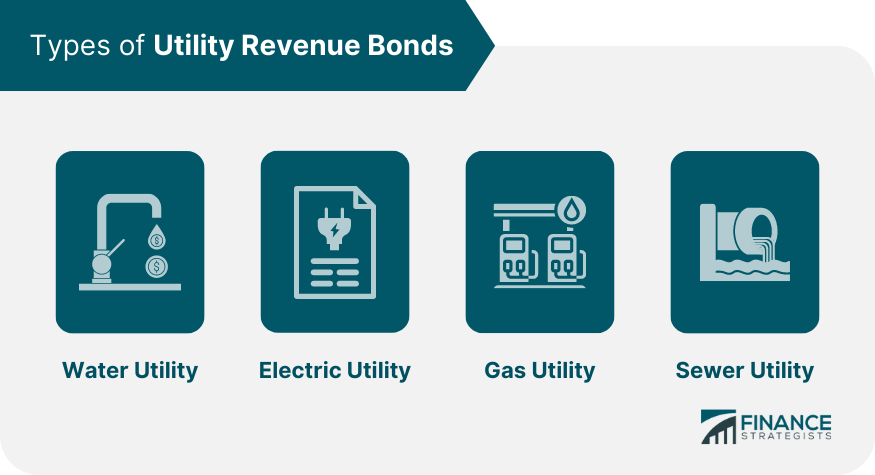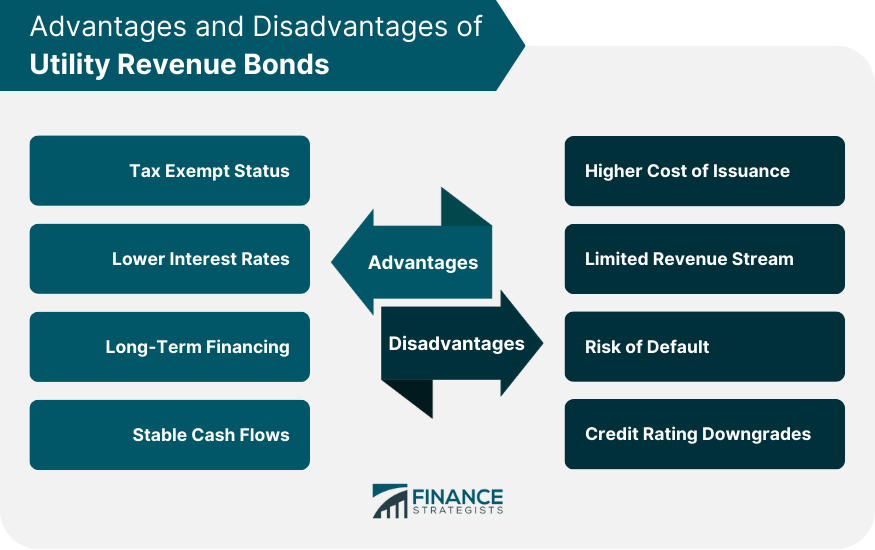A utility revenue bond is a type of municipal bond that is issued to finance the construction or improvement of public utility facilities such as water, electric, gas, or sewer systems. These bonds are backed by the revenue generated by the utility, and the interest and principal payments are funded from the revenues generated by the utility. The purpose of a utility revenue bond is to provide long-term financing for the construction or improvement of public utility facilities. These bonds allow utilities to raise capital to fund large-scale projects without relying on tax revenues or other sources of government funding. Utility revenue bonds are typically issued by state and local governments and are exempt from federal income tax, making them an attractive investment for investors seeking tax-exempt income. Utility revenue bonds are important because they enable local governments to provide essential public services such as water, electricity, and gas to their residents. These bonds help to finance the construction and maintenance of critical infrastructure that supports the economy and improves the quality of life for residents. Additionally, utility revenue bonds can provide a stable source of long-term financing for utilities, which can help to keep rates affordable for consumers. A water utility revenue bond is a type of municipal bond that is issued to finance the construction or improvement of water utility facilities such as water treatment plants, reservoirs, and distribution systems. These bonds are backed by the revenue generated by the water utility and are typically used to fund projects that improve the quality and reliability of the water supply. An electric utility revenue bond is a type of municipal bond that is issued to finance the construction or improvement of electric utility facilities such as power plants, transmission lines, and substations. These bonds are backed by the revenue generated by the electric utility and are typically used to fund projects that increase the capacity and reliability of the electric grid. A gas utility revenue bond is a type of municipal bond that is issued to finance the construction or improvement of gas utility facilities such as pipelines, storage facilities, and distribution systems. These bonds are backed by the revenue generated by the gas utility and are typically used to fund projects that improve the safety and reliability of the gas supply. A sewer utility revenue bond is a type of municipal bond that is issued to finance the construction or improvement of sewer utility facilities such as treatment plants, collection systems, and wastewater disposal systems. These bonds are backed by the revenue generated by the sewer utility and are typically used to fund projects that improve the quality and safety of the wastewater system. One of the primary advantages of utility revenue bonds is their tax-exempt status. These bonds are exempt from federal income tax, making them an attractive investment for investors seeking tax-exempt income. Additionally, some utility revenue bonds may be exempt from state and local taxes, further increasing their attractiveness to investors. Utility revenue bonds typically offer lower interest rates than other types of municipal bonds. This is because these bonds are backed by the revenue generated by the utility, which provides a stable source of income for investors. Additionally, the tax-exempt status of these bonds can make them more attractive to investors, which can help to lower the cost of borrowing for utilities. Utility revenue bonds provide long-term financing for utilities, which enables them to fund large-scale projects over an extended period of time. This can help utilities to avoid the need for short-term financing, which can be more expensive and less predictable than long-term financing. Utility revenue bonds provide a stable source of income for investors, which can help to stabilize cash flows for utilities. Because these bonds are backed by the revenue generated by the utility, they provide a predictable source of income for investors, which can help to ensure that utilities have the financial resources they need to maintain and improve their infrastructure. One of the primary disadvantages of utility revenue bonds is the higher cost of issuance compared to other types of municipal bonds. This is because utility revenue bonds require more complex credit analysis and may require additional legal fees and other expenses. Additionally, the underwriting fees for utility revenue bonds may be higher than other types of municipal bonds due to the specialized nature of these securities. Another disadvantage of utility revenue bonds is the limited revenue stream available to support the bonds. Because these bonds are backed by the revenue generated by the utility, the revenue stream may be subject to fluctuations in demand or other factors that can affect the financial performance of the utility. This can increase the risk of default for investors, which can lead to lower credit ratings and higher borrowing costs for utilities. Utility revenue bonds are subject to the risk of default, just like any other type of bond. If the utility is unable to generate sufficient revenue to support the bonds, it may default on its obligations to investors, which can lead to a loss of principal and interest. This risk can be mitigated through careful credit analysis and diversification of investments, but it cannot be eliminated entirely. If the credit rating of the utility issuing the bonds is downgraded, the cost of borrowing for the utility may increase, which can lead to higher rates for consumers. This can make it more difficult for the utility to generate sufficient revenue to support the bonds, which can increase the risk of default. Additionally, a credit rating downgrade can lead to a decline in the value of the bonds, which can result in a loss for investors. The first step in issuing a utility revenue bond is to conduct a feasibility study to determine the financial feasibility of the project. This study will include an analysis of the projected revenue stream, operating expenses, and capital requirements for the project, as well as an assessment of the creditworthiness of the utility issuing the bonds. Once the feasibility study is complete, the utility will typically seek a credit rating assessment from a rating agency such as Standard & Poor's or Moody's. The rating agency will evaluate the creditworthiness of the utility and assign a credit rating based on factors such as the utility's financial performance, debt levels, and market conditions. Once the credit rating assessment is complete, the utility will work with an underwriter to structure the bond offering and prepare the necessary documentation. The underwriter will also help to market the bonds to potential investors and ensure that the bond offering complies with all applicable regulations. The final step in the process of issuing a utility revenue bond is to price the bonds. This involves setting the interest rate and other terms of the bond offering based on market conditions and investor demand. Once the bonds are priced, they are sold to investors, and the proceeds are used to finance the construction or improvement of the public utility facilities. The issuer of a utility revenue bond is the government agency or utility company that is responsible for issuing the bonds. The issuer is responsible for conducting the feasibility study, obtaining the credit rating assessment, and working with the underwriter to structure the bond offering and prepare the necessary documentation. The underwriter is a financial institution that helps to structure the bond offering and market the bonds to potential investors. The underwriter also ensures that the bond offering complies with all applicable regulations and helps to set the interest rate and other terms of the bond offering. Bond counsel is a law firm that provides legal advice and support to the issuer and underwriter during the bond offering process. Bond counsel is responsible for ensuring that the bond offering complies with all applicable laws and regulations and helps to prepare the necessary legal documentation. Credit rating agencies such as Standard & Poor's and Moody's provide credit rating assessments for the issuer, which help investors to evaluate the creditworthiness of the issuer and assess the risk of default. Credit rating agencies also provide ongoing monitoring and analysis of the issuer's financial performance, which can affect the credit rating of the bonds. Utility revenue bonds play an essential role in financing the construction and improvement of public utility facilities such as water, electric, gas, and sewer systems. These bonds provide long-term financing for utilities and offer several advantages, including tax-exempt status, lower interest rates, and stable cash flows. However, they also have some disadvantages, including a higher cost of issuance, a limited revenue stream, and the risk of default. Issuing a utility revenue bond involves a complex process that includes a feasibility study, credit rating assessment, bond underwriting, and bond pricing. Key players in the process include the issuer, underwriter, bond counsel, and credit rating agencies. By carefully evaluating the advantages and disadvantages of utility revenue bonds and working with experienced professionals, issuers can ensure that they are able to obtain the necessary financing to support critical infrastructure projects and provide essential public services to their communities.What Is a Utility Revenue Bond?
Importance of Utility Revenue Bonds
Types of Utility Revenue Bonds
Water Utility Revenue Bond
Electric Utility Revenue Bond
Gas Utility Revenue Bond
Sewer Utility Revenue Bond

Advantages of Utility Revenue Bonds
Tax Exempt Status
Lower Interest Rates
Long-Term Financing
Stable Cash Flows
Disadvantages of Utility Revenue Bonds
Higher Cost of Issuance
Limited Revenue Stream
Risk of Default
Credit Rating Downgrades

Process of Issuing Utility Revenue Bonds
Feasibility Study
Credit Rating Assessment
Bond Underwriting
Bond Pricing
Key Players in Issuing Utility Revenue Bonds
Issuer
Underwriter
Bond Counsel
Credit Rating Agencies
Bottom Line
Utility Revenue Bond FAQs
Utility revenue bonds are a type of municipal bond issued to finance utility projects such as water, electric, gas, or sewer services.
Utility revenue bonds have tax-exempt status, lower interest rates, long-term financing, and stable cash flows.
The key players involved in issuing utility revenue bonds include the issuer, underwriter, bond counsel, and credit rating agencies.
Utility revenue bonds have higher costs of issuance, a limited revenue stream, a risk of default, and credit rating downgrades.
The types of utility revenue bonds include water, electric, gas, and sewer utility revenue bonds, each designed to finance specific types of utility projects.
True Tamplin is a published author, public speaker, CEO of UpDigital, and founder of Finance Strategists.
True is a Certified Educator in Personal Finance (CEPF®), author of The Handy Financial Ratios Guide, a member of the Society for Advancing Business Editing and Writing, contributes to his financial education site, Finance Strategists, and has spoken to various financial communities such as the CFA Institute, as well as university students like his Alma mater, Biola University, where he received a bachelor of science in business and data analytics.
To learn more about True, visit his personal website or view his author profiles on Amazon, Nasdaq and Forbes.













